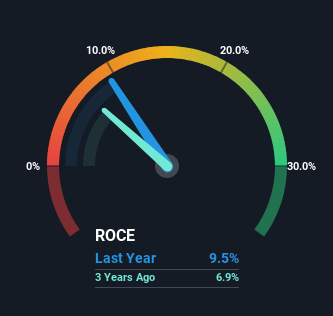- United States
- /
- Commercial Services
- /
- NYSE:GEO
GEO Group (NYSE:GEO) Is Experiencing Growth In Returns On Capital
What are the early trends we should look for to identify a stock that could multiply in value over the long term? Amongst other things, we'll want to see two things; firstly, a growing return on capital employed (ROCE) and secondly, an expansion in the company's amount of capital employed. Ultimately, this demonstrates that it's a business that is reinvesting profits at increasing rates of return. With that in mind, we've noticed some promising trends at GEO Group (NYSE:GEO) so let's look a bit deeper.
What Is Return On Capital Employed (ROCE)?
For those that aren't sure what ROCE is, it measures the amount of pre-tax profits a company can generate from the capital employed in its business. To calculate this metric for GEO Group, this is the formula:
Return on Capital Employed = Earnings Before Interest and Tax (EBIT) ÷ (Total Assets - Current Liabilities)
0.095 = US$312m ÷ (US$3.6b - US$340m) (Based on the trailing twelve months to December 2024).
Therefore, GEO Group has an ROCE of 9.5%. On its own, that's a low figure but it's around the 11% average generated by the Commercial Services industry.
View our latest analysis for GEO Group

Above you can see how the current ROCE for GEO Group compares to its prior returns on capital, but there's only so much you can tell from the past. If you'd like, you can check out the forecasts from the analysts covering GEO Group for free.
How Are Returns Trending?
GEO Group is showing promise given that its ROCE is trending up and to the right. The figures show that over the last five years, ROCE has grown 23% whilst employing roughly the same amount of capital. So it's likely that the business is now reaping the full benefits of its past investments, since the capital employed hasn't changed considerably. It's worth looking deeper into this though because while it's great that the business is more efficient, it might also mean that going forward the areas to invest internally for the organic growth are lacking.
What We Can Learn From GEO Group's ROCE
In summary, we're delighted to see that GEO Group has been able to increase efficiencies and earn higher rates of return on the same amount of capital. Since the stock has returned a staggering 183% to shareholders over the last five years, it looks like investors are recognizing these changes. In light of that, we think it's worth looking further into this stock because if GEO Group can keep these trends up, it could have a bright future ahead.
If you'd like to know more about GEO Group, we've spotted 3 warning signs, and 1 of them shouldn't be ignored.
If you want to search for solid companies with great earnings, check out this free list of companies with good balance sheets and impressive returns on equity.
New: Manage All Your Stock Portfolios in One Place
We've created the ultimate portfolio companion for stock investors, and it's free.
• Connect an unlimited number of Portfolios and see your total in one currency
• Be alerted to new Warning Signs or Risks via email or mobile
• Track the Fair Value of your stocks
Have feedback on this article? Concerned about the content? Get in touch with us directly. Alternatively, email editorial-team (at) simplywallst.com.
This article by Simply Wall St is general in nature. We provide commentary based on historical data and analyst forecasts only using an unbiased methodology and our articles are not intended to be financial advice. It does not constitute a recommendation to buy or sell any stock, and does not take account of your objectives, or your financial situation. We aim to bring you long-term focused analysis driven by fundamental data. Note that our analysis may not factor in the latest price-sensitive company announcements or qualitative material. Simply Wall St has no position in any stocks mentioned.
About NYSE:GEO
GEO Group
Owns, leases, operates, and manages secure facilities, processing centers, and community-based reentry facilities in the United States, Australia, the United Kingdom, and South Africa.
Good value with reasonable growth potential.
Similar Companies
Market Insights
Community Narratives



